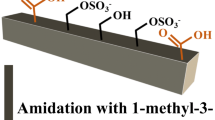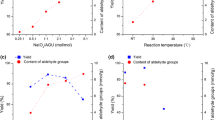Abstract
This study demonstrates regioselective oxidation of cellulose nanowhiskers using 2.80–10.02 mmols of sodium periodate per 5 g of whiskers followed by grafting with methyl and butyl amines through a Schiff base reaction to obtain their amine derivatives in 80–90 % yield. We found a corresponding increase in carbonyl content (0.06–0.14 mmols/g) of the dialdehyde cellulose nanowhiskers with the increase in oxidant as measured by titrimetric analysis and this was further evidenced by FT-IR spectroscopy. Grafting of amine compounds to the oxidized cellulose nanowhiskers resulted in their amine derivatives, which are found to be partially soluble in DMSO. Therefore, the reduction reaction between amines and carbonyl groups was confirmed through 13C NMR spectra, which was also supported by copper titration, XPS, and FT-IR spectroscopy. Morphological integrity and crystallinity of the nanowhiskers was maintained after the chemical modification as studied by AFM and solid-state 13C NMR, respectively.








Similar content being viewed by others
References
Alonso D, Gimeno M, Olayo R, Vazquez-Torres H, Sepulveda-Sanchez JD, Shirai K (2009) Cross-linking chitosan into UV-irradiated cellulose fibers for the preparation of antimicrobial-finished textiles. Carbohydr Polym 77(3):536–543. doi:10.1016/j.carbpol.2009.01.027
Angellier H, Molina-Boisseau S, Belgacem MN, Dufresne A (2005) Surface chemical modification of waxy maize starch nanocrystals. Langmuir 21(6):2425–2433. doi:10.1021/la047530j
Araki J, Wada M, Kuga S (2001) Steric stabilization of a cellulose microcrystal suspension by poly(ethylene glycol) grafting. Langmuir 17(1):21–27. doi:10.1021/la001070m
Azizi Samir MAS, Alloin F, Dufresne A (2005) Review of recent research into cellulosic whiskers, their properties and their application in nanocomposite field. Biomacromolecules 6(2):612–626. doi:10.1021/bm0493685
Beck-Candanedo S, Roman M, Gray DG (2005) Effect of reaction conditions on the properties and behavior of wood cellulose nanocrystal suspensions. Biomacromolecules 6(2):1048–1054. doi:10.1021/bm049300p
Bondeson D, Mathew A, Oksman K (2006) Optimization of the isolation of nanocrystals from microcrystalline cellulose by acid hydrolysis. Cellulose 13(2):171–180. doi:10.1007/s10570-006-9061-4
Cassano R, Trombino S, Ferrarelli T, Muzzalupo R, Tavano L, Picci N (2009) Synthesis and antibacterial activity evaluation of a novel cotton fiber (Gossypium barbadense) ampicillin derivative. Carbohydr Polym 78(3):639–641. doi:10.1016/j.carbpol.2009.05.030
Cetin NS, Tingaut P, Ozmen N, Henry N, Harper D, Dadmun M, Sebe G (2009) Acetylation of cellulose nanowhiskers with vinyl acetate under moderate conditions. Macromol Biosci 9(10):997–1003. doi:10.1002/mabi.200900073
Dash R, Ragauskas AJ (2012) Synthesis of a novel cellulose nanowhisker-based drug delivery system. RSC Adv 2(8):3403–3409. doi:10.1039/c2ra01071b
Dufresne A (2008) Polysaccharide nano crystal reinforced nanocomposites. Can J Chem 86(6):484–494. doi:10.1139/v07-152
Eichhorn SJ (2011) Cellulose nanowhiskers: promising materials for advanced applications. Soft Matter 7(2):303–315. doi:10.1039/c0sm00142b
El-Tahlawy KF, El-Bendary MA, Elhendawy AG, Hudson SM (2005) The antimicrobial activity of cotton fabrics treated with different crosslinking agents and chitosan. Carbohydr Polym 60(4):421–430. doi:10.1016/j.carbpol.2005.02.019
Fujisawa S, Saito T, Isogai A (2012) Nano-dispersion of TEMPO-oxidized cellulose/aliphatic amine salts in isopropyl alcohol. Cellulose 19(2):459–466. doi:10.1007/s10570-011-9648-2
Gousse C, Chanzy H, Excoffier G, Soubeyrand L, Fleury E (2002) Stable suspensions of partially silylated cellulose whiskers dispersed in organic solvents. Polymer 43(9):2645–2651. doi:10.1016/s0032-3861(02)00051-4
Habibi Y, Chanzy H, Vignon MR (2006) TEMPO-mediated surface oxidation of cellulose whiskers. Cellulose 13(6):679–687. doi:10.1007/s10570-006-9075-y
Habibi Y, Lucia LA, Rojas OJ (2010) Cellulose nanocrystals: chemistry, self-assembly, and applications. Chem Rev 110(6):3479–3500. doi:10.1021/cr900339w
Harrisson S, Drisko GL, Malmstrom E, Hult A, Wooley KL (2011) Hybrid rigid/soft and biologic/synthetic materials: polymers grafted onto cellulose microcrystals. Biomacromolecules 12(4):1214–1223. doi:10.1021/bm101506j
Hasani M, Cranston ED, Gray DG (2009) Cationic surface functionalization of cellulose nanocrystals. Abstracts of Papers of the American Chemical Society 237
Huang JG, Ichinose I, Kunitake T (2006) Biomolecular modification of hierarchical cellulose fibers through titania nanocoating. Angew Chem Int Ed Engl 45(18):2883–2886. doi:10.1002/anie.200503867
John MJ, Thomas S (2008) Biofibres and biocomposites. Carbohydr Polym 71(3):343–364. doi:10.1016/j.carbpol.2007.05.040
Johnson R, Zink-Sharp A, Glasser W (2011) Preparation and characterization of hydrophobic derivatives of TEMPO-oxidized nanocelluloses. Cellulose 18(6):1599–1609. doi:10.1007/s10570-011-9579-y
Kim UJ, Kuga S, Wada M, Okano T, Kondo T (2000) Periodate oxidation of crystalline cellulose. Biomacromolecules 1(3):488–492. doi:10.1021/bm0000337
Klemm D, Kramer F, Moritz S, Lindstrom T, Ankerfors M, Gray D, Dorris A (2011) Nanocelluloses: a new family of nature-based materials. Angew Chem Int Ed Engl 50(24):5438–5466. doi:10.1002/anie.201001273
Kristiansen KA, Potthast A, Christensen BE (2010) Periodate oxidation of polysaccharides for modification of chemical and physical properties. Carbohydr Res 345(10):1264–1271. doi:10.1016/j.carres.2010.02.011
Larsson PT, Hult EL, Wickholm K, Pettersson E, Iversen T (1999) CP/MAS C-13-NMR spectroscopy applied to structure and interaction studies on cellulose I. Solid State Nucl Magn Reson 15(1):31–40. doi:10.1016/s0926-2040(99)00044-2
Lima MMD, Borsali R (2004) Rodlike cellulose microcrystals: structure, properties, and applications. Macromol Rapid Commun 25(7):771–787. doi:10.1002/marc.200300268
Majoinen J, Walther A, McKee JR, Kontturi E, Aseyev V, Malho JM, Ruokolainen J, Ikkala O (2011) Polyelectrolyte brushes grafted from cellulose nanocrystals using Cu-mediated surface-initiated controlled radical polymerization. Biomacromolecules 12(8):2997–3006. doi:10.1021/bm200613y
Montanari S, Rountani M, Heux L, Vignon MR (2005) Topochemistry of carboxylated cellulose nanocrystals resulting from TEMPO-mediated oxidation. Macromolecules 38(5):1665–1671. doi:10.1021/ma048396c
Morandi G, Heath L, Thielemans W (2009) Cellulose nanocrystals grafted with polystyrene chains through surface-initiated atom transfer radical polymerization (SI-ATRP). Langmuir 25(14):8280–8286. doi:10.1021/la900452a
Nair KG, Dufresne A, Gandini A, Belgacem MN (2003) Crab shell chitin whiskers reinforced natural rubber nanocomposites. 3. effect of chemical modification of chitin whiskers. Biomacromolecules 4(6):1835–1842. doi:10.1021/bm030058g
Park S, Baker JO, Himmel ME, Parilla PA, Johnson DK (2010) Cellulose crystallinity index: measurement techniques and their impact on interpreting cellulase performance. Biotechnology for Biofuels 3. doi:10.1186/1754-6834-3-10
Peng BL, Dhar N, Liu HL, Tam KC (2011) Chemistry and applications of nanocrystalline cellulose and its derivatives: a nanotechnology perspective. Can J Chem Eng 89(5):1191–1206. doi:10.1002/cjce.20554
Peresin MS, Habibi Y, Zoppe JO, Pawlak JJ, Rojas OJ (2010) Nanofiber composites of polyvinyl alcohol and cellulose nanocrystals: manufacture and characterization. Biomacromolecules 11(3):674–681. doi:10.1021/bm901254n
Potthast A, Kostic M, Schiehser S, Kosma P, Rosenau T (2007) Studies on oxidative modifications of cellulose in the periodate system: molecular weight distribution and carbonyl group profiles. Holzforschung 61(6):662–667. doi:10.1515/hf.2007.099
Ringot C, Sol V, Barriere M, Saad N, Bressollier P, Granet R, Couleaud P, Frochot C, Krausz P (2011) Triazinyl porphyrin-based photoactive cotton fabrics: preparation, characterization, and antibacterial activity. Biomacromolecules 12(5):1716–1723. doi:10.1021/bm200082d
Rohrling J, Potthast A, Rosenau T, Lange T, Borgards A, Sixta H, Kosma P (2002) A novel method for the determination of carbonyl groups in cellulosics by fluorescence labeling. 2. validation and applications. Biomacromolecules 3(5):969–975. doi:10.1021/bm020030p
Sassi JF, Chanzy H (1995) Ultrastructural aspects of the acetylation of cellulose. Cellulose 2(2):111–127. doi:10.1007/bf00816384
Siqueira G, Bras J, Dufresne A (2009) Cellulose Whiskers versus microfibrils: influence of the nature of the nanoparticle and its surface functionalization on the thermal and mechanical properties of nanocomposites. Biomacromolecules 10(2):425–432. doi:10.1021/bm801193d
Yuan HH, Nishiyama Y, Wada M, Kuga S (2006) Surface acylation of cellulose whiskers by drying aqueous emulsion. Biomacromolecules 7(3):696–700. doi:10.1021/bm050828j
Zhang J, Jiang N, Dang Z, Elder TJ, Ragauskas AJ (2008) Oxidation and sulfonation of cellulosics. Cellulose 15(3):489–496. doi:10.1007/s10570-007-9193-1
Acknowledgments
The authors thank DOE (DE-EE0003144) for the support of this study.
Author information
Authors and Affiliations
Corresponding author
Rights and permissions
About this article
Cite this article
Dash, R., Elder, T. & Ragauskas, A.J. Grafting of model primary amine compounds to cellulose nanowhiskers through periodate oxidation. Cellulose 19, 2069–2079 (2012). https://doi.org/10.1007/s10570-012-9769-2
Received:
Accepted:
Published:
Issue Date:
DOI: https://doi.org/10.1007/s10570-012-9769-2




